Microstructural Evolution in a 6060 Extrudable Al-Alloy: Integrated Modeling and Experimental Validation
Abstract
1. Introduction
2. Materials and Methods
2.1. Simulation Methodology
2.1.1. Solidification
2.1.2. Solidification Cooling
2.1.3. Homogenization
2.1.4. Extrusion Cooling and Artificial Aging
2.1.5. Strengthening
2.2. Experimental Methodology
2.2.1. Material
2.2.2. Characterization
2.2.3. Tensile Testing
3. Results and Discussion
3.1. Simulation Results
3.1.1. Solidification
3.1.2. Solidification Cooling and Homogenization
3.1.3. Simulation of Precipitation during Extrusion Cooling
3.1.4. Simulation of Precipitation during Aging
3.1.5. Yield Strength Evolution during Aging
3.2. Characterization and Experimental Validation
3.2.1. Characterization of the As-Cast Material
3.2.2. Characterization of the As-Homogenized Material
3.2.3. Experimental Validation of Solidification and Homogenization Simulations
3.2.4. Characterization of the as-Extruded Material
3.2.5. Characterization of the Aged Material
3.2.6. Experimental Validation of Precipitation Model
4. Conclusions
- Solidification and homogenization calculations were in excellent agreement with experimental measurements in the as-cast and homogenized materials. Calculations predict the presence of coarse α-AlFeSi, β-AlFeSi, β-Mg2Si, π-phase and eutectics containing diamond (Si) after solidification cooling, agreeing with SEM-EDX measurements. The elimination of the cast structure, the dissolution of β-Mg2Si, π-phase and eutectics, and the completion of the β-AlFeSi to α-AlFeSi transformation upon homogenization is also predicted, in accordance with the SEM-EDX observations.
- Regarding the as-extruded material, coarse β-Mg2Si particles were not found on dispersoids, grain boundaries or α-AlFeSi particles, after extrusion using SEM-EDX. However, coarse, overaging particles of metastable β-type phases including β′, U1, U2 and B′, were observed on dispersoids and grain boundaries, via TEM in the aged material. The particles nucleated during cooling after extrusion and grew over the course of aging.
- The formation of overaging precipitates near grain boundaries and dispersoids is associated with the development of Precipitate-Free Zones (PFZs), where the strengthening phase β″ does not form upon aging. Extended PFZs were observed in the aged material, resulting from a relatively low extrusion cooling rate.
- In the aged condition, TEM analysis revealed a fine dispersion of needle-shaped precipitates, identified as the fully coherent β″, with a volume fraction 0.91%, a mean radius of 2.8 nm and a mean length of 40 nm.
- Simulations of precipitation kinetics during extrusion cooling and aging predicted the evolution of the volume fraction, number density, radius and length distributions of β″ needles, in excellent agreement with TEM observations. Minor discrepancies regarding precipitate length were observed. The increase in yield strength due to the precipitation of β″ was accurately predicted, with results showing that peak hardness was achieved when the precipitate size was approaching the transition from coherency to Orowan strengthening.
- Precipitation simulations revealed that most β″ precipitates were nucleated during the first aging holding at the low aging temperature (165–180 °C), due to a high driving force for precipitation. Yet growth remained slow, due to limited diffusion at low temperatures. During the second isothermal holding at the high aging temperature (195–210 °C), the volume fraction increased as particles grow rapidly.
- Simulation predictions presented good agreement with experimental measurements, indicating that the modeling approach can be used to optimize the composition and processing conditions of extrudable 6xxx aluminum alloys.
- With key microstructural features modeled at critical processing stages and calibrated with targeted experiments, the optimization of process parameters is enabled. The approach has the potential of minimizing trial-and-error experiments required to optimize the properties of extrudable Al alloys, reducing time and effort, therefore improving efficiency.
Author Contributions
Funding
Institutional Review Board Statement
Informed Consent Statement
Data Availability Statement
Acknowledgments
Conflicts of Interest
References
- Wang, Q.G.; Davidson, C.J. Solidification and Precipitation Behaviour of Al-Si-Mg Casting Alloys. J. Mater. Sci. 2001, 36, 739–750. [Google Scholar] [CrossRef]
- Liu, Y.L.; Kang, S.B. The Solidification Process of Al–Mg–Si Alloys. J. Mater. Sci. 1997, 32, 1443–1447. [Google Scholar] [CrossRef]
- Que, Z.; Wang, Y.; Mendis, C.L.; Fang, C.; Xia, J.; Zhou, X.; Fan, Z. Understanding Fe-Containing Intermetallic Compounds in Al Alloys: An Overview of Recent Advances from the LiME Research Hub. Metals 2022, 12, 1677. [Google Scholar] [CrossRef]
- Saha, P.K. Aluminum Extrusion Technology; ASM International: Detroit, MI, USA, 2000. [Google Scholar]
- Sarafoglou, P.I.; Serafeim, A.; Fanikos, I.A.; Aristeidakis, J.S.; Haidemenopoulos, G.N. Modeling of Microsegregation and Homogenization of 6xxx Al-Alloys Including Precipitation and Strengthening During Homogenization Cooling. Materials 2019, 12, 1421. [Google Scholar] [CrossRef] [PubMed]
- Mukhopadhyay, P. Alloy Designation, Processing, and Use of AA6XXX Series Aluminium Alloys. Int. Sch. Res. Notices 2012, 2012, 165082. [Google Scholar] [CrossRef]
- Menapace, C.; Bernard, F.; Lusa, M.; Ischia, G.; Straffelini, G. Effect of a Dual-Rate Ageing Treatment on the Tensile Properties of a Commercial 6060 Al Alloy. Mater. Sci. Eng. A 2021, 819, 141468. [Google Scholar] [CrossRef]
- Yang, M.; Ruan, Z.; Lin, H.; Li, K.; Yang, M.; Wang, Z.; Lan, X.; Xie, Y.; Xiao, Y.; Yan, Q.; et al. Quantified Effect of Quench Rate on the Microstructures and Mechanical Properties of an Al–Mg–Si Alloy. J. Mater. Res. Technol. 2023, 24, 6753–6761. [Google Scholar] [CrossRef]
- Du, Y.; Chang, Y.A.; Liu, S.; Huang, B.; Xie, F.-Y.; Yang, Y.; Chen, S.-L. Thermodynamic Description of the Al–Fe–Mg–Mn–Si System and Investigation of Microstructure and Microsegregation during Directional Solidification of an Al–Fe–Mg–Mn–Si Alloy. Z. Für Met. 2005, 96, 1351–1362. [Google Scholar] [CrossRef]
- Cinkilic, E.; Ridgeway, C.D.; Yan, X.; Luo, A.A. A Formation Map of Iron-Containing Intermetallic Phases in Recycled Cast Aluminum Alloys. Metall. Mater. Trans. A 2019, 50, 5945–5956. [Google Scholar] [CrossRef]
- Sarafoglou, P.I.; Haidemenopoulos, G.N. Phase Fraction Mapping in the As-Cast Microstructure of Extrudable 6xxx Aluminum Alloys. Int. J. Mater. Res. 2014, 105, 1202–1209. [Google Scholar] [CrossRef]
- Kuijpers, N.C.; Vermolen, F.J.; Vuik, K.; van der Zwaag, S. A Model of the β-AlFeSi to α-Al (FeMn) Si Transformation in Al-Mg-Si Alloys. Mater. Trans. 2003, 44, 1448–1456. [Google Scholar] [CrossRef]
- Kuijpers, N.C.W.; Vermolen, F.J.; Vuik, C.; Koenis, P.T.G.; Nilsen, K.E.; Zwaag, S. van der The Dependence of the β-AlFeSi to α-Al(FeMn)Si Transformation Kinetics in Al–Mg–Si Alloys on the Alloying Elements. Mater. Sci. Eng. A 2005, 394, 9–19. [Google Scholar] [CrossRef]
- Du, Q.; Jia, L.; Tang, K.; Holmedal, B. Modelling and Experimental Validation of Microstructure Evolution during the Cooling Stage of Homogenization Heat Treatment of Al–Mg–Si Alloys. Materialia 2018, 4, 70–80. [Google Scholar] [CrossRef]
- Priya, P.; Johnson, D.R.; Krane, M.J.M. Numerical Study of Microstructural Evolution During Homogenization of Al-Si-Mg-Fe-Mn Alloys. Metall. Mater. Trans. A 2016, 47, 4625–4639. [Google Scholar] [CrossRef]
- Milkereit, B.; Starink, M.J. Quench Sensitivity of Al–Mg–Si Alloys: A Model for Linear Cooling and Strengthening. Mater. Des. 2015, 76, 117–129. [Google Scholar] [CrossRef]
- Myhr, O.R.; Grong, Ø.; Fjær, H.G.; Marioara, C.D. Modelling of the Microstructure and Strength Evolution in Al–Mg–Si Alloys during Multistage Thermal Processing. Acta Mater. 2004, 52, 4997–5008. [Google Scholar] [CrossRef]
- Myhr, O.R.; Grong, Ø. Modelling of Non-Isothermal Transformations in Alloys Containing a Particle Distribution. Acta Mater. 2000, 48, 1605–1615. [Google Scholar] [CrossRef]
- Myhr, O. Modelling of the Age Hardening Behaviour of Al–Mg–Si Alloys. Acta Mater. 2001, 49, 65–75. [Google Scholar] [CrossRef]
- Du, Q.; Poole, W.J.; Wells, M.A. A Mathematical Model Coupled to CALPHAD to Predict Precipitation Kinetics for Multicomponent Aluminum Alloys. Acta Mater. 2012, 60, 3830–3839. [Google Scholar] [CrossRef]
- Du, Q.; Tang, K.; Marioara, C.D.; Andersen, S.J.; Holmedal, B.; Holmestad, R. Modeling Over-Ageing in Al-Mg-Si Alloys by a Multi-Phase CALPHAD-Coupled Kampmann-Wagner Numerical Model. Acta Mater. 2017, 122, 178–186. [Google Scholar] [CrossRef]
- Kleiven, D.; Akola, J. Precipitate Formation in Aluminium Alloys: Multi-Scale Modelling Approach. Acta Mater. 2020, 195, 123–131. [Google Scholar] [CrossRef]
- Baganis, A.; Bouzouni, M.; Papaefthymiou, S. Phase Field Simulation of AA6XXX Aluminium Alloys Heat Treatment. Metals 2021, 11, 241. [Google Scholar] [CrossRef]
- Andersson, J.-O.; Helander, T.; Höglund, L.; Shi, P.; Sundman, B. Thermo-Calc & DICTRA, Computational Tools for Materials Science. Calphad 2002, 26, 273–312. [Google Scholar] [CrossRef]
- Larsson, H.; Höglund, L. Multiphase Diffusion Simulations in 1D Using the DICTRA Homogenization Model. Calphad 2009, 33, 495–501. [Google Scholar] [CrossRef]
- Chen, H.-L.; Chen, Q.; Engström, A. Development and Applications of the TCAL Aluminum Alloy Database. Calphad 2018, 62, 154–171. [Google Scholar] [CrossRef]
- Chen, Q.; Sundman, B. Computation of Partial Equilibrium Solidification with Complete Interstitial and Negligible Substitutional Solute Back Diffusion. Mater. Trans. 2002, 43, 551–559. [Google Scholar] [CrossRef]
- Aziz, M.J.; Kaplan, T. Continuous Growth Model for Interface Motion during Alloy Solidification. Acta Metal. 1988, 36, 2335–2347. [Google Scholar] [CrossRef]
- Bocklund, B.; Bobbio, L.D.; Otis, R.A.; Beese, A.M.; Liu, Z.-K. Experimental Validation of Scheil–Gulliver Simulations for Gradient Path Planning in Additively Manufactured Functionally Graded Materials. Materialia 2020, 11, 100689. [Google Scholar] [CrossRef]
- Sarafoglou, P.I.; Aristeidakis, J.S.; Tzini, M.-I.T.; Haidemenopoulos, G.N. Metallographic Index-Based Quantification of the Homogenization State in Extrudable Aluminum Alloys. Metals 2016, 6, 121. [Google Scholar] [CrossRef]
- Bardel, D.; Perez, M.; Nelias, D.; Deschamps, A.; Hutchinson, C.R.; Maisonnette, D.; Chaise, T.; Garnier, J.; Bourlier, F. Coupled Precipitation and Yield Strength Modelling for Non-Isothermal Treatments of a 6061 Aluminium Alloy. Acta Mater. 2014, 62, 129–140. [Google Scholar] [CrossRef]
- Haryadi, D.; Rudianto, H. Study of First Principles of Mg-Si Binary Systems as Precipitates from T6 Heat Treatment of AL-MG-SI ALLOYS. Indones. J. Appl. Phys. 2020, 10, 16–23. [Google Scholar] [CrossRef]
- Andersen, S.J.; Zandbergen, H.W.; Jansen, J.; TrÆholt, C.; Tundal, U.; Reiso, O. The Crystal Structure of the Β″ Phase in Al–Mg–Si Alloys. Acta Mater. 1998, 46, 3283–3298. [Google Scholar] [CrossRef]
- Wang, Y.; Liu, Z.K.; Chen, L.Q.; Wolverton, C. First-Principles Calculations of Β″-Mg5Si6/α-Al Interfaces. Acta Mater. 2007, 55, 5934–5947. [Google Scholar] [CrossRef]
- Zander, J.; Sandström, R. One Parameter Model for Strength Properties of Hardenable Aluminium Alloys. Mater. Des. 2008, 29, 1540–1548. [Google Scholar] [CrossRef]
- Seidman, D.N.; Marquis, E.A.; Dunand, D.C. Precipitation Strengthening at Ambient and Elevated Temperatures of Heat-Treatable Al(Sc) Alloys. Acta Mater. 2002, 50, 4021–4035. [Google Scholar] [CrossRef]
- Andersen, S.J. Quantification of the Mg2Si Β″ and Β′ Phases in AlMgSi Alloys by Transmission Electron Microscopy. Metall. Mater. Trans. A 1995, 26, 1931–1937. [Google Scholar] [CrossRef]
- Ninive, P.H.; Strandlie, A.; Gulbrandsen-Dahl, S.; Lefebvre, W.; Marioara, C.D.; Andersen, S.J.; Friis, J.; Holmestad, R.; Løvvik, O.M. Detailed Atomistic Insight into the Β″ Phase in Al-Mg-Si Alloys. Acta Mater. 2014, 69, 126–134. [Google Scholar] [CrossRef]
- Ravi, C.; Wolverton, C. First-Principles Study of Crystal Structure and Stability of Al–Mg–Si–(Cu) Precipitates. Acta Mater. 2004, 52, 4213–4227. [Google Scholar] [CrossRef]
- Matsuda, K.; Sakaguchi, Y.; Miyata, Y.; Uetani, Y.; Sato, T.; Kamio, A.; Ikeno, S. Precipitation Sequence of Various Kinds of Metastable Phases in Al-1.0mass% Mg2Si-0.4mass% Si Alloy. J. Mater. Sci. 2000, 35, 179–189. [Google Scholar] [CrossRef]
- Chen, H.; Lu, J.; Kong, Y.; Li, K.; Yang, T.; Meingast, A.; Yang, M.; Lu, Q.; Du, Y. Atomic Scale Investigation of the Crystal Structure and Interfaces of the B′ Precipitate in Al-Mg-Si Alloys. Acta Mater. 2020, 185, 193–203. [Google Scholar] [CrossRef]
- Strobel, K.; Easton, M.A.; Sweet, L.; Couper, M.J.; Nie, J.-F. Relating Quench Sensitivity to Microstructure in 6000 Series Aluminium Alloys. Mater. Trans. 2011, 52, 914–919. [Google Scholar] [CrossRef]
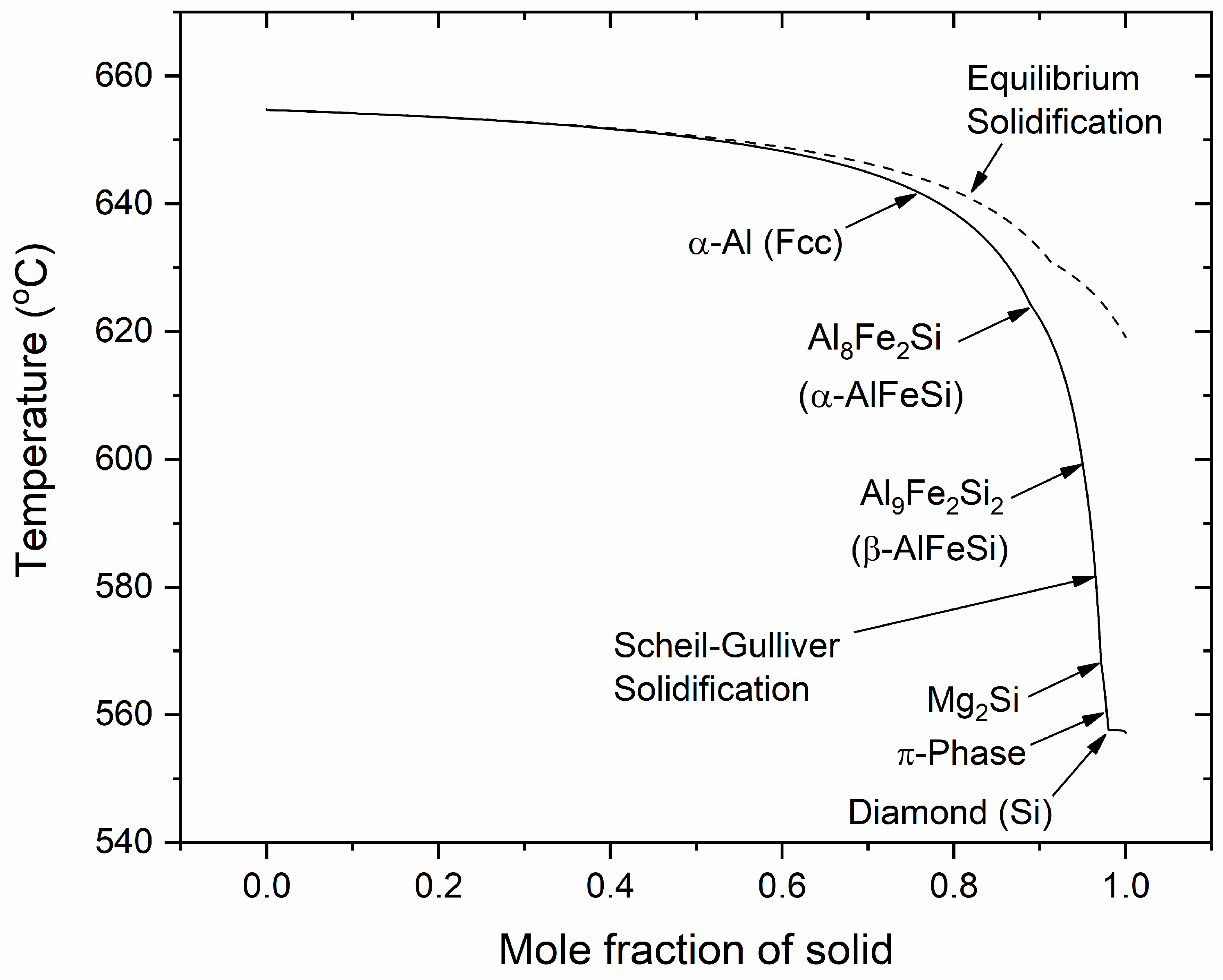
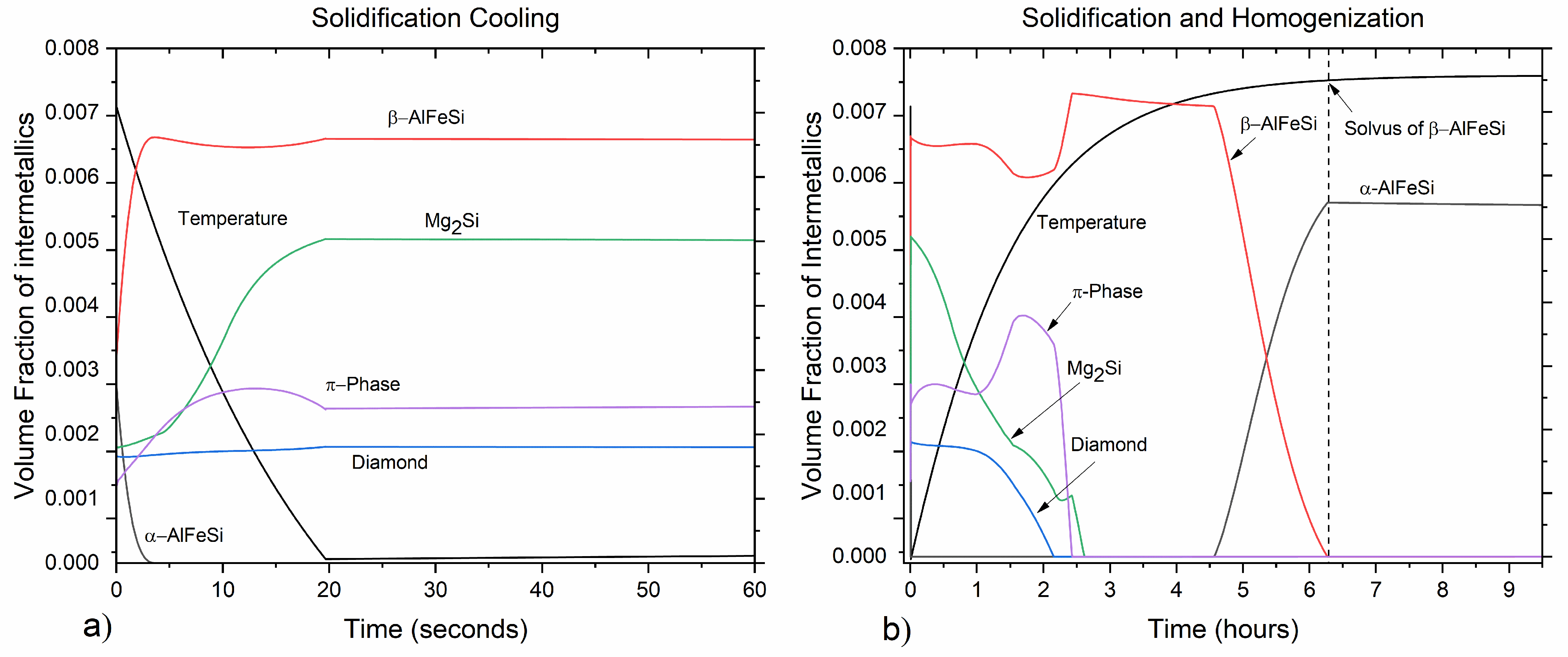
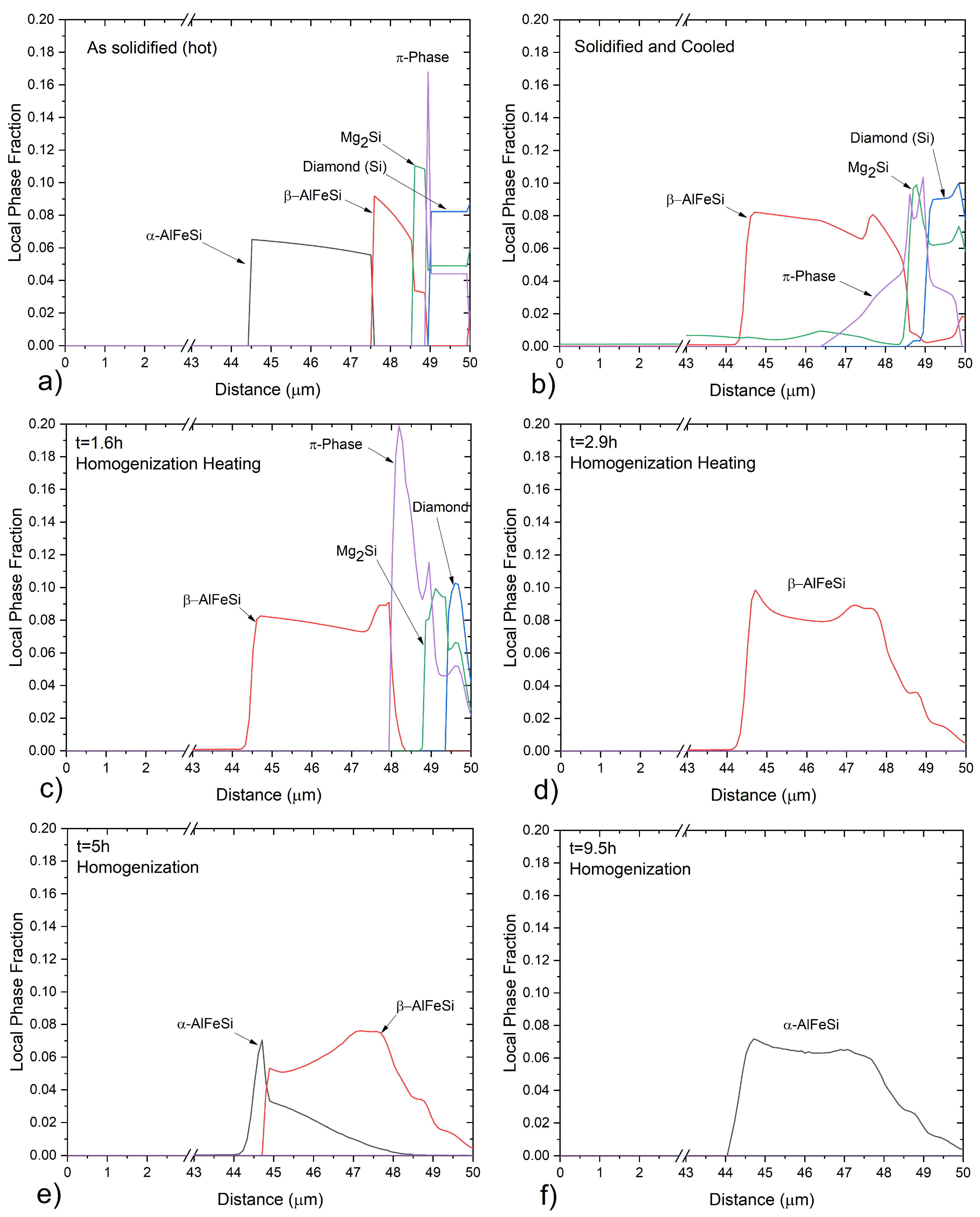
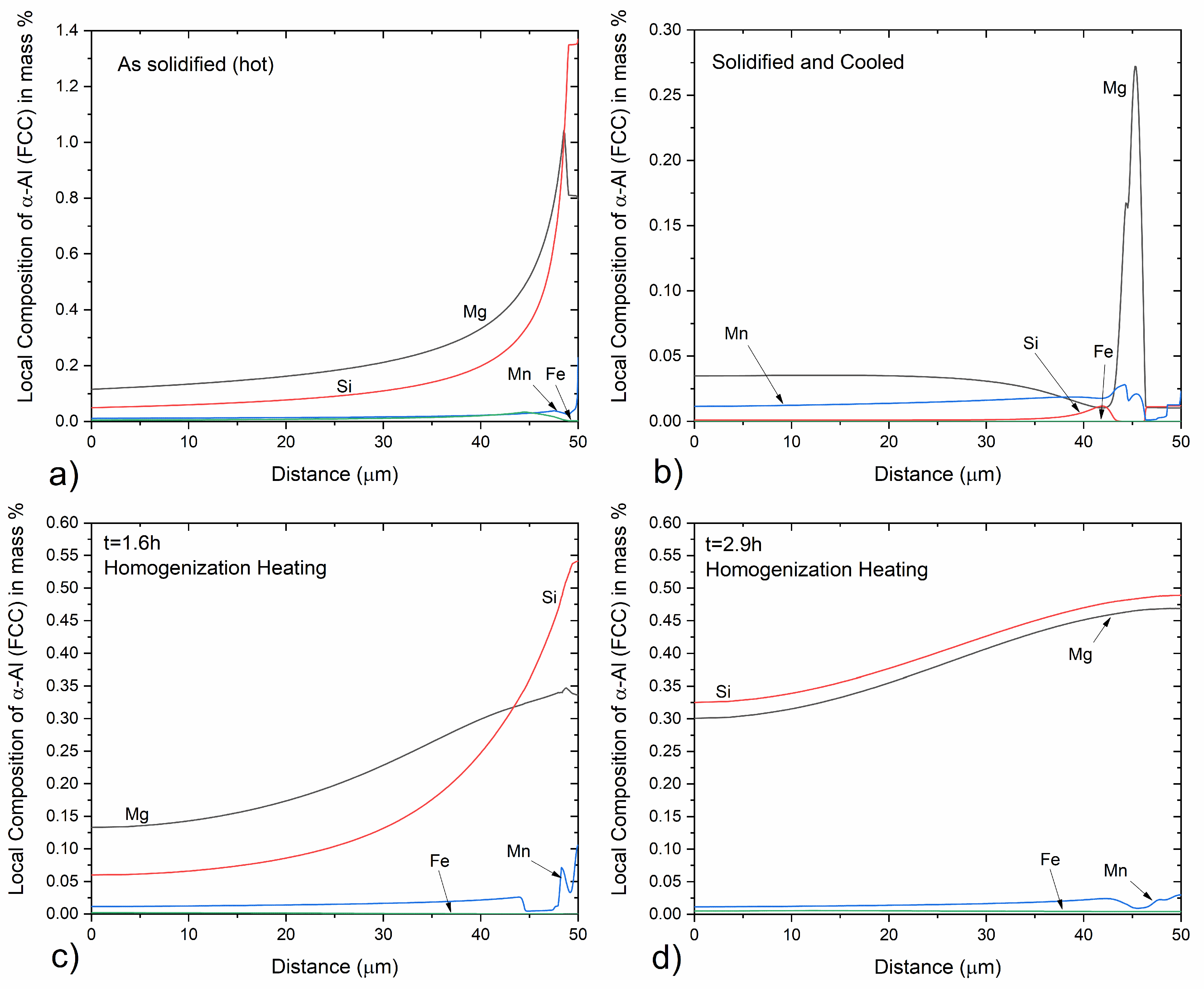

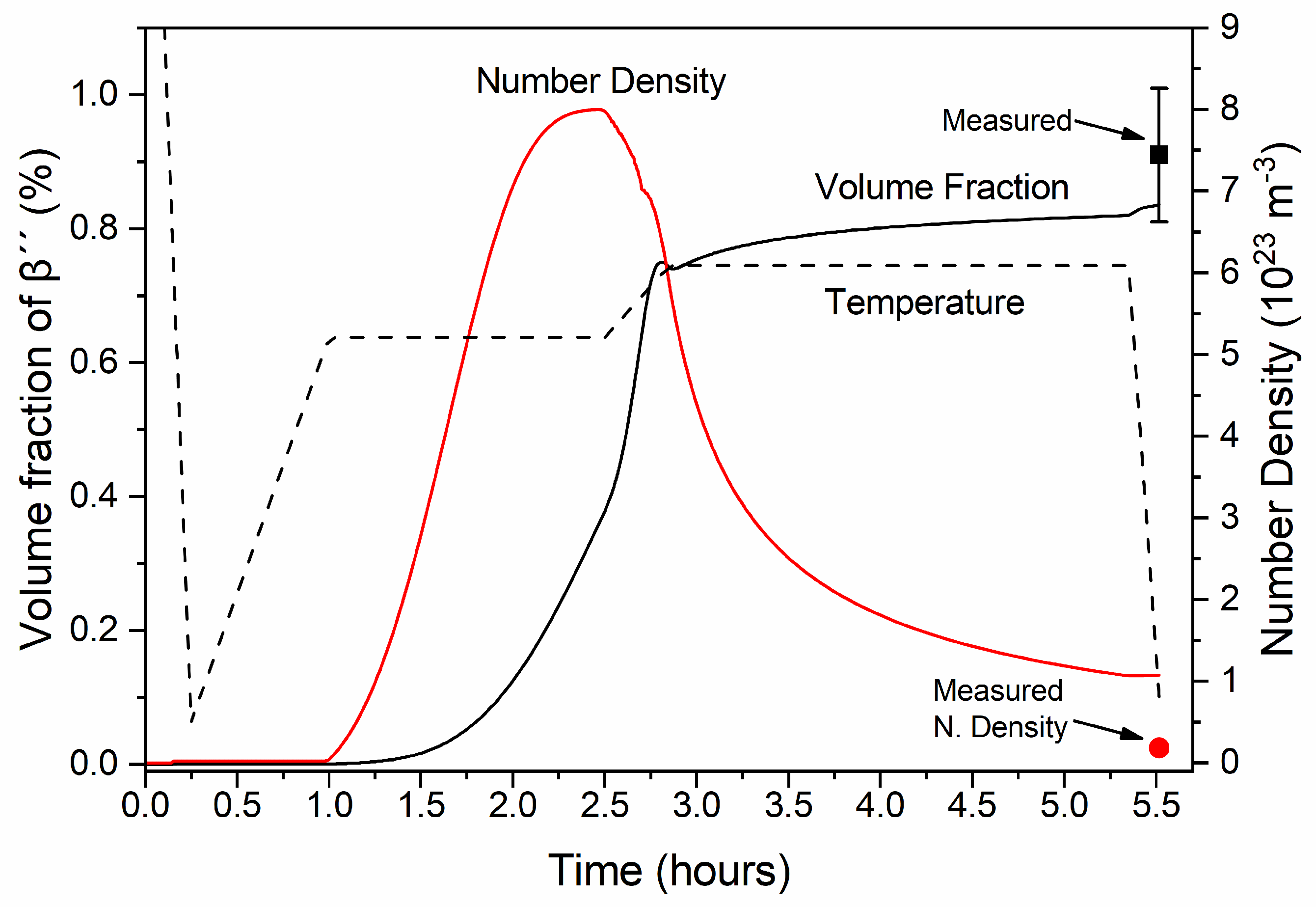
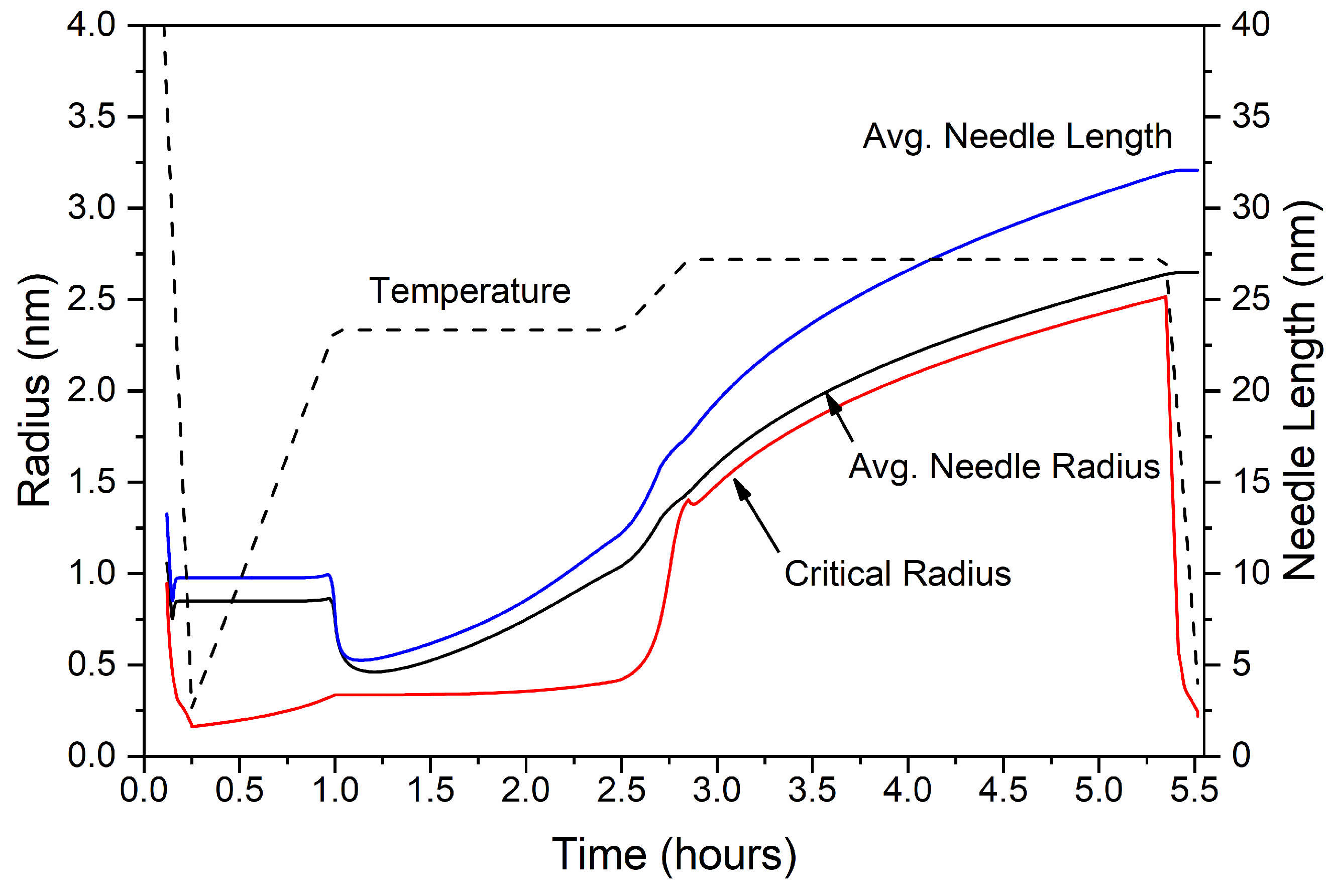
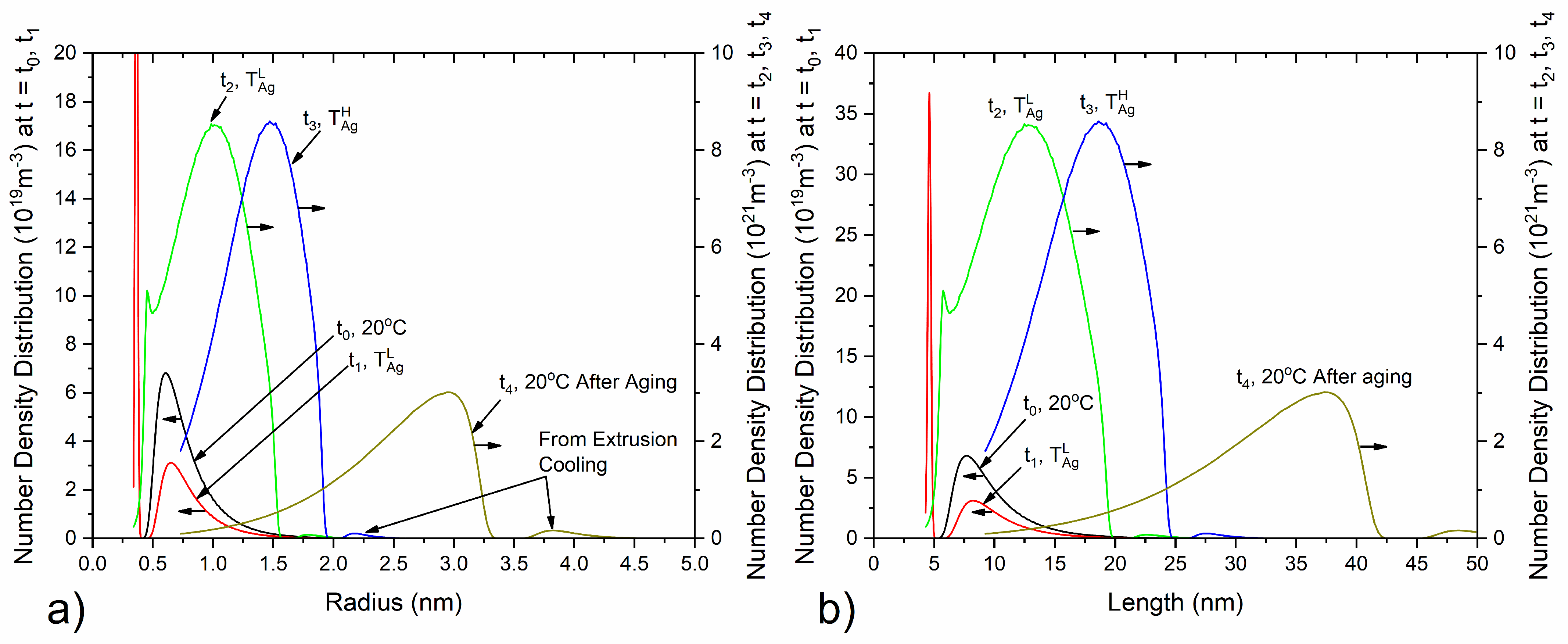


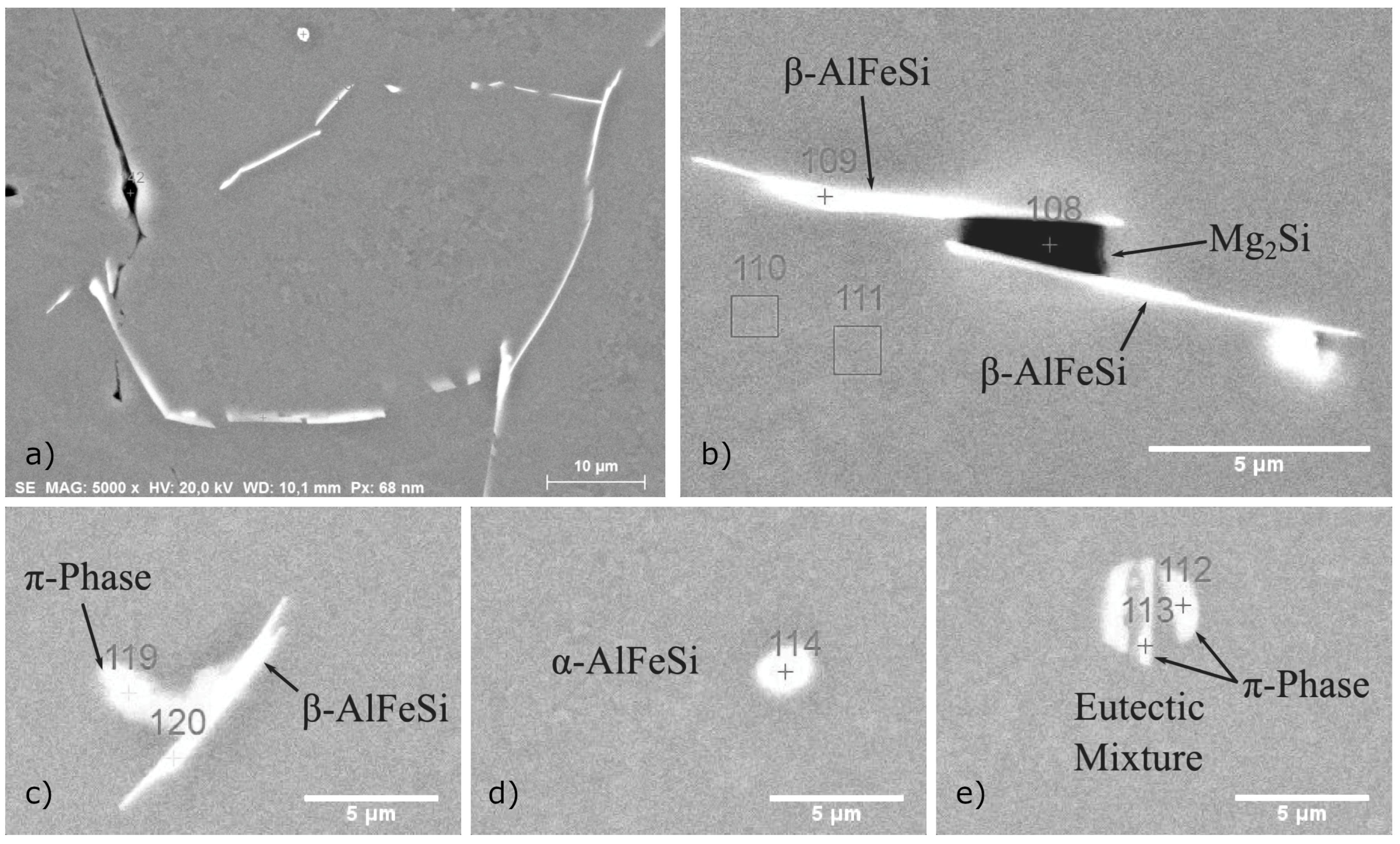

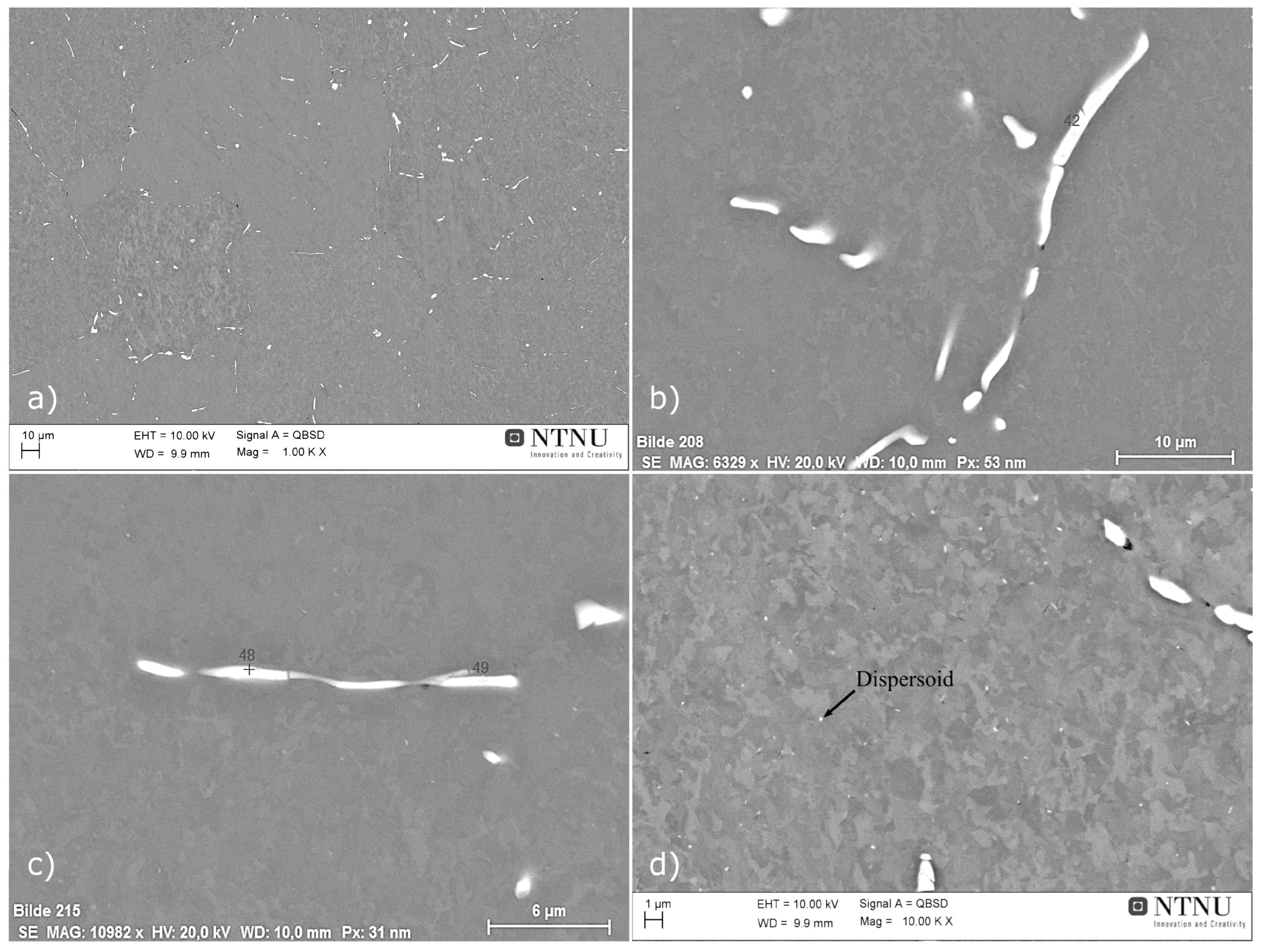
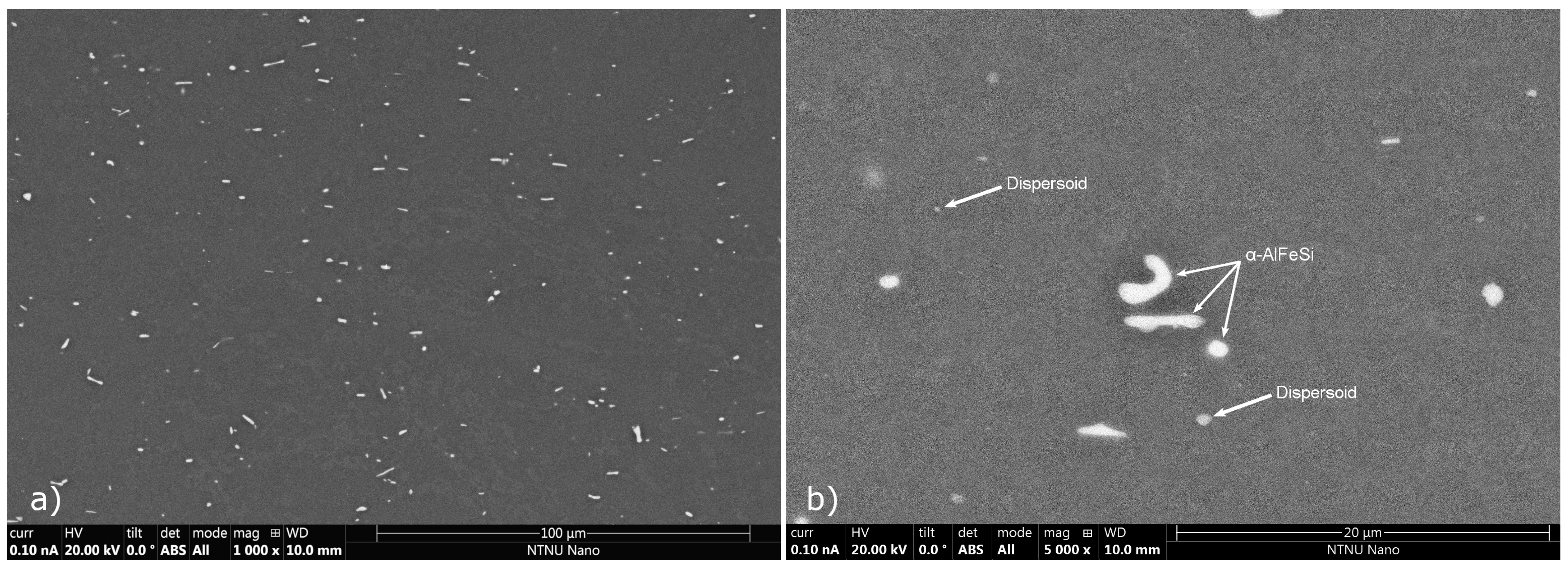
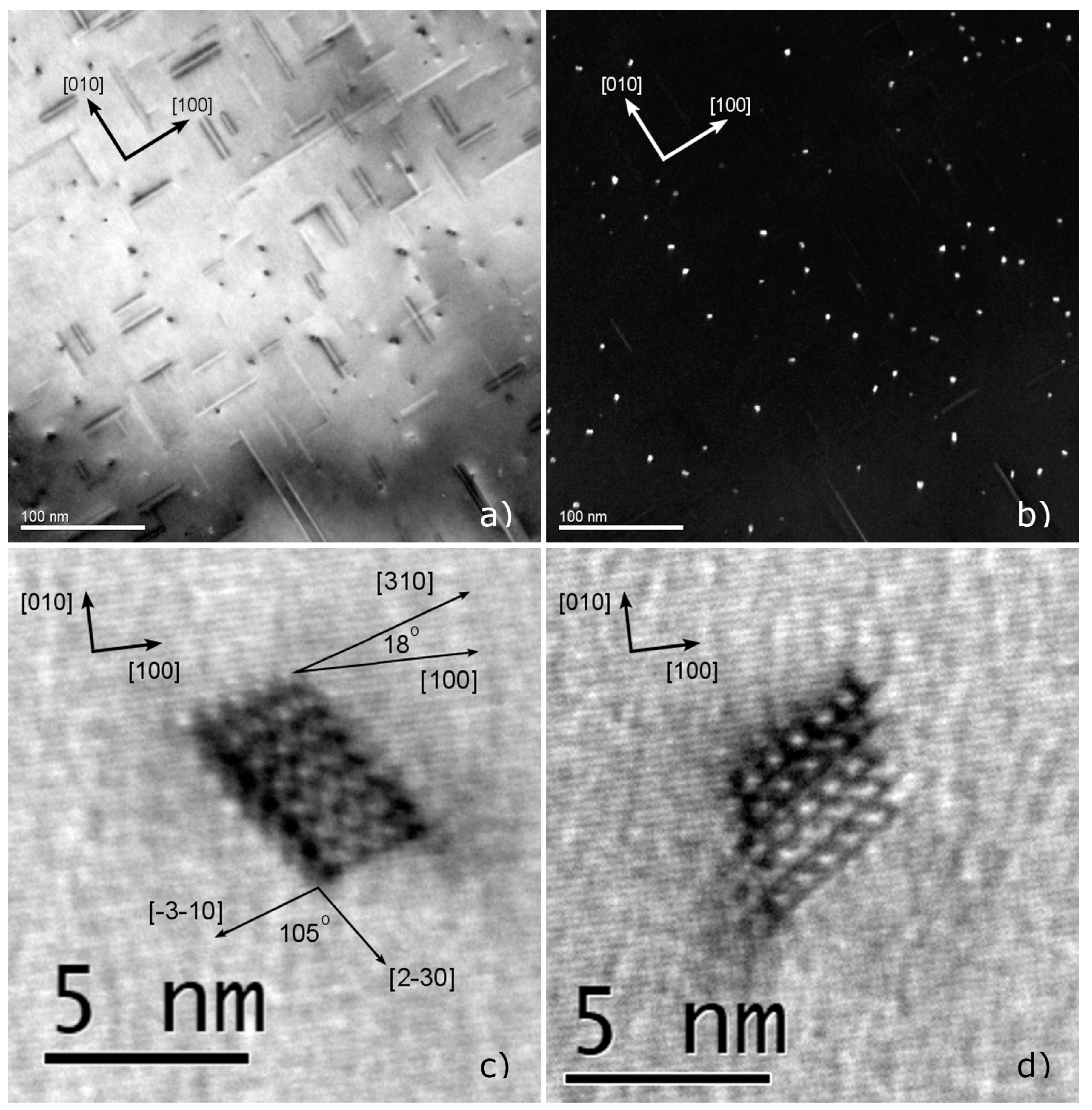
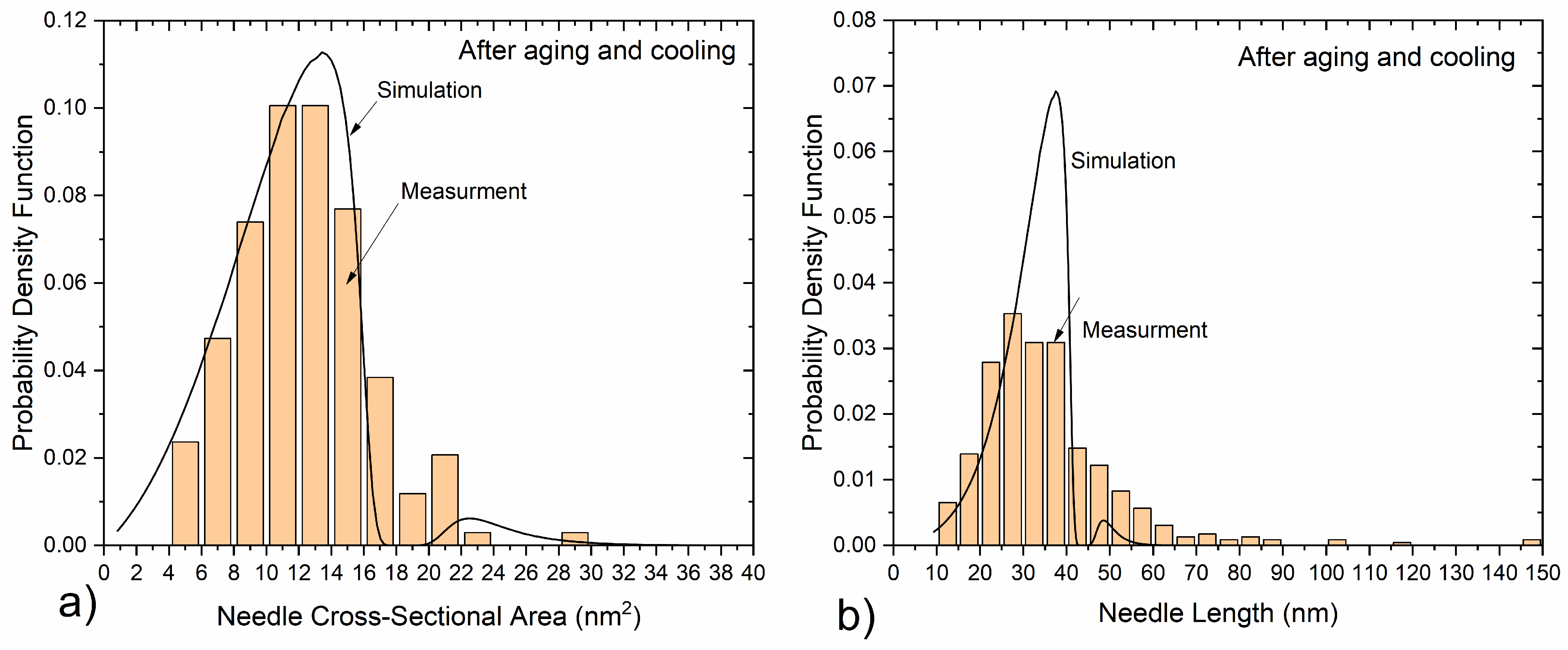
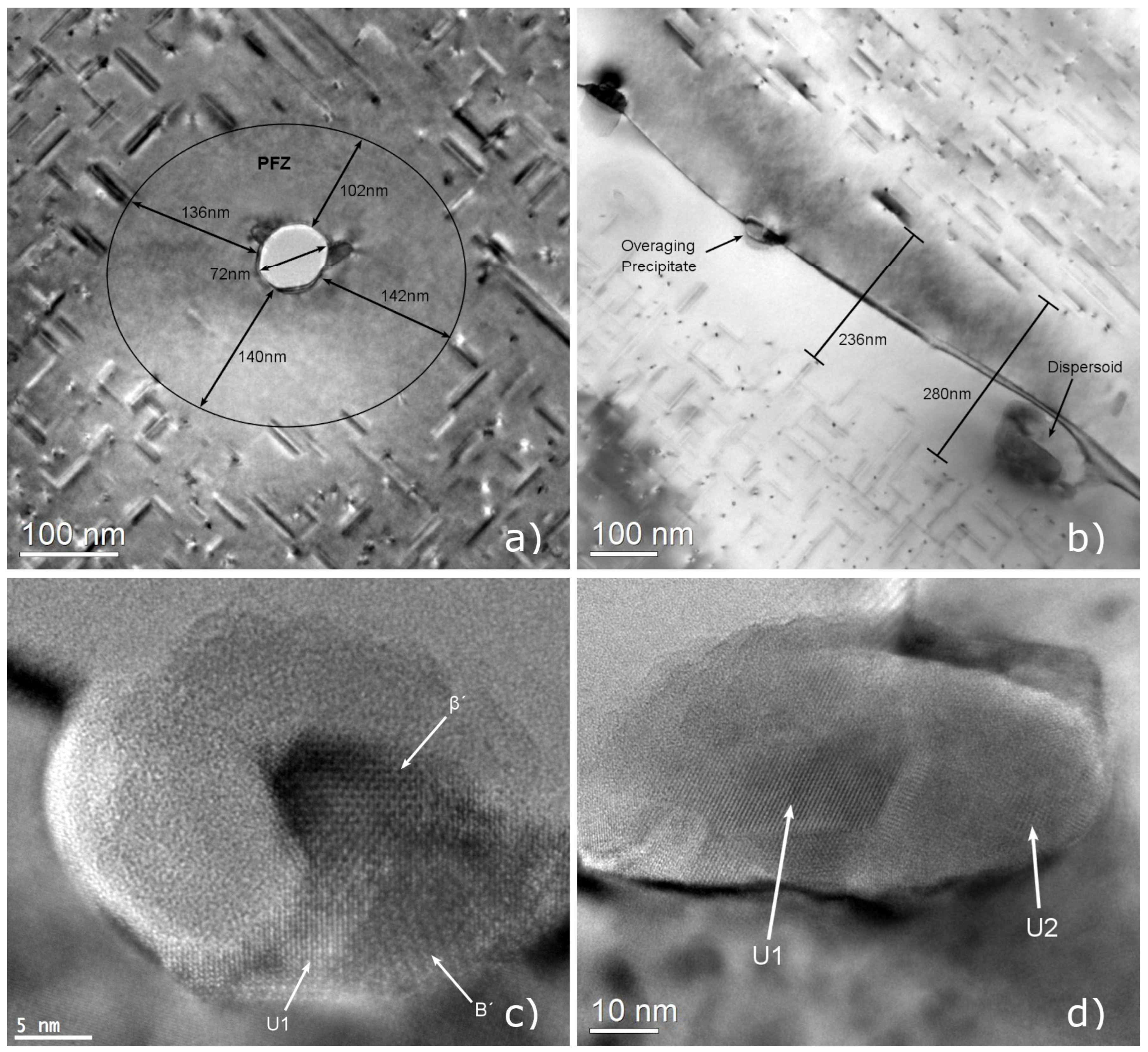
| Measured Volume Fraction | Predicted Volume Fraction | |
|---|---|---|
| β-AlFeSi + α-AlFeSi + π-Phase + Eutectics | 1.2 ± 0.1% | 1.199% |
| Blocky β-Mg2Si | 0.017 ± 0.003% | 0.087% |
| Measured Volume Fraction | Predicted Volume Fraction | |
|---|---|---|
| α-AlFeSi | 0.6% | 0.554% |
| β-AlFeSi | 0% | 0% |
| Blocky β-Mg2Si | 0.026% | 0% |
| π-Phase | 0% | 0% |
| Eutectics | 0% | 0% |
| Measurement | (nm2) | (nm) | (nm) | (m−3) | (%) | |
|---|---|---|---|---|---|---|
| Value | 12.3 | 40 | 2.83 | 7.06 | 1.85·1022 | 0.91 |
| Measurement | Prediction | |
|---|---|---|
| As-extruded material | ||
| Yield strength (MPa) | 70.5 | 72.8 |
| Aged material | ||
| (%) | 0.91 | 0.837 |
| Number density of β″ N (m−3) | 1.85·1022 | 1.08·1023 |
| (nm) | 2.83 | 2.65 |
| (nm) | 40 | 32 |
| Yield strength (MPa) | 208 | 211 |
Disclaimer/Publisher’s Note: The statements, opinions and data contained in all publications are solely those of the individual author(s) and contributor(s) and not of MDPI and/or the editor(s). MDPI and/or the editor(s) disclaim responsibility for any injury to people or property resulting from any ideas, methods, instructions or products referred to in the content. |
© 2024 by the authors. Licensee MDPI, Basel, Switzerland. This article is an open access article distributed under the terms and conditions of the Creative Commons Attribution (CC BY) license (https://creativecommons.org/licenses/by/4.0/).
Share and Cite
Aristeidakis, J.S.; Haidemenopoulos, G.N.; Bjørge, R.; Marioara, C.D.; Kamoutsi, H.; Giarmas, E.; Rafailidis, N. Microstructural Evolution in a 6060 Extrudable Al-Alloy: Integrated Modeling and Experimental Validation. Materials 2024, 17, 545. https://doi.org/10.3390/ma17030545
Aristeidakis JS, Haidemenopoulos GN, Bjørge R, Marioara CD, Kamoutsi H, Giarmas E, Rafailidis N. Microstructural Evolution in a 6060 Extrudable Al-Alloy: Integrated Modeling and Experimental Validation. Materials. 2024; 17(3):545. https://doi.org/10.3390/ma17030545
Chicago/Turabian StyleAristeidakis, John S., Gregory N. Haidemenopoulos, Ruben Bjørge, Calin D. Marioara, Helen Kamoutsi, Evangelos Giarmas, and Nikolaos Rafailidis. 2024. "Microstructural Evolution in a 6060 Extrudable Al-Alloy: Integrated Modeling and Experimental Validation" Materials 17, no. 3: 545. https://doi.org/10.3390/ma17030545
APA StyleAristeidakis, J. S., Haidemenopoulos, G. N., Bjørge, R., Marioara, C. D., Kamoutsi, H., Giarmas, E., & Rafailidis, N. (2024). Microstructural Evolution in a 6060 Extrudable Al-Alloy: Integrated Modeling and Experimental Validation. Materials, 17(3), 545. https://doi.org/10.3390/ma17030545







